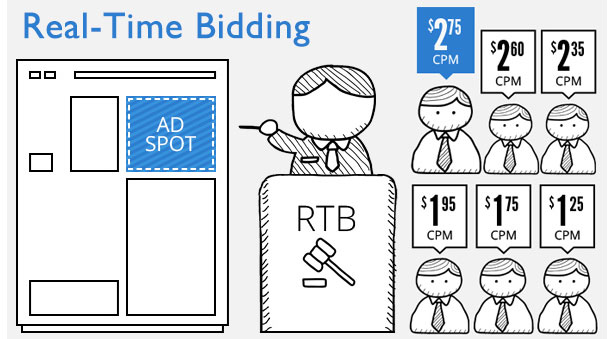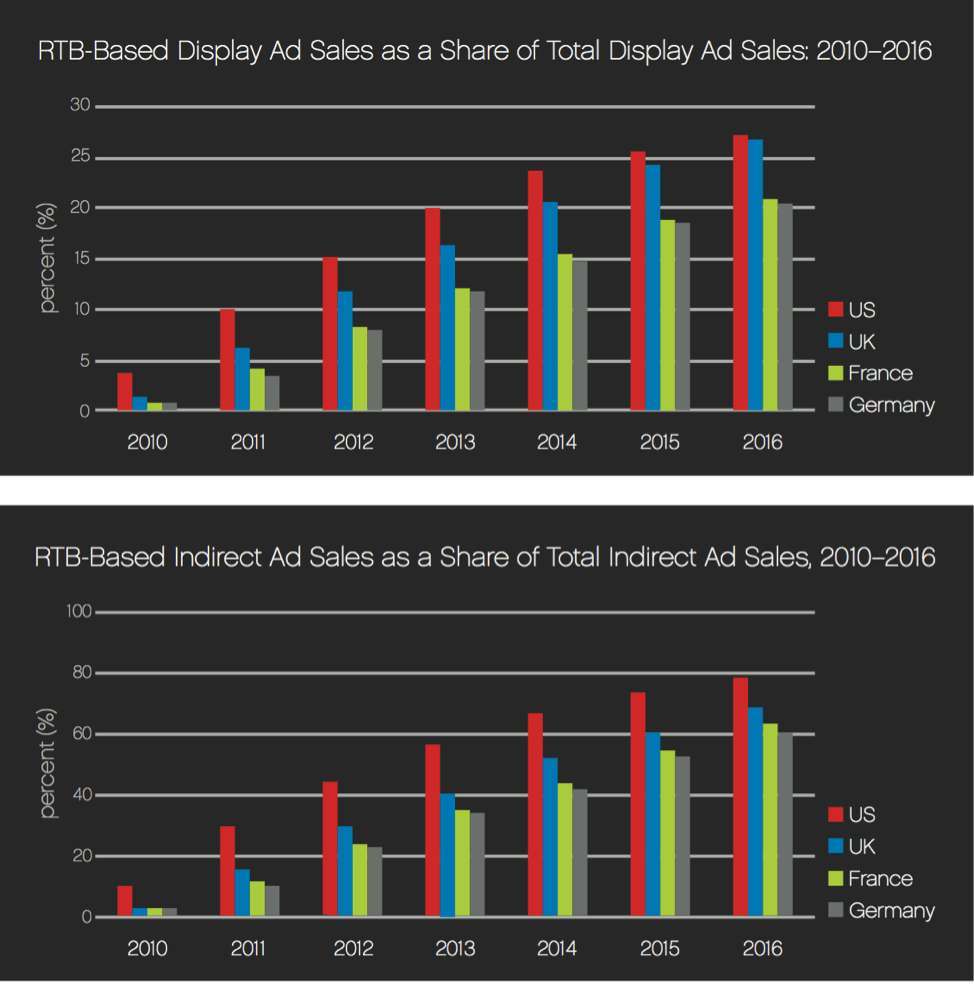Why RTB technology failed to conquer the European advertising market

The technology of purchasing real-time advertising based on auction (Real-Time Bidding - RTB) in the United States is very popular and very common. However, on the other side of the Atlantic - in Europe - the situation is not so optimistic. Despite the great advances and high expectations that accompanied the emergence of RTB in the Old World, this technology has not yet succeeded in taking those peaks that it seemed to be conquering playfully.
RTB is still growing in Europe and, in general, not at such a bad pace, however, expectations were much higher. The reasons for not such outstanding results RTB devoted report of the company AdMonsters. Today we will study this interesting document more closely.
')
RTB in Europe
Appearing just a few years ago, Real-Time Bidding technology managed to change how digital advertising in the US is bought and sold. RTB systems give advertising agencies and advertisers more control over how the advertising budget is spent. Increased customer control capabilities have led to the emergence of a number of new players in the online advertising market: third-party data providers, automatic purchase systems (Demand Side Platforms - DSP), data management platforms or suppliers (Data Management Platforms - DMP), etc. d.
In Europe, this process is only gaining momentum. Experts (in particular, Kartsen Wade from IDC) predict an increase in sales of RTB advertising in Western Europe from $ 227 million in 2011 to $ 2.5 billion in 2016. The share of RTB among all expenses for display advertising will grow from 3% to 19%.

However, one obstacle stands in the way of growth. His name is advertising platforms (or “publishers”, as they are called). Advertisers quickly tried out the benefits of the new technology, which cannot be said about the administration of Internet sites where banners are placed.
A joint survey of companies Digiday and PubMatic in 2011 showed that only 20% of sites offered advertising with the help of RTB-systems. At the same time, already at that time, the number of advertisers who somehow worked with this technology was as much as 62%.
At the moment, the situation has not changed much, and European Internet sites are still wary of RTB. And this is despite a number of seemingly quite significant advantages:
- More customers - obviously, if advertisers are interested in this technology, then the possibility of placing banners with it will contribute to the growth of site revenue. Less inventory (for example, impressions) will remain unsold, and CPM and revenue from the display will increase.
- Convenience management ad inventory. In addition to increased CPM, RTB technology allows for more efficient management of inventory that is difficult to sell directly (“premium placement”). According to Google, the overhead of managing advertising campaigns can be from 8% to 28% of the total campaign budget (for comparison, in the case of TV advertising, this figure does not exceed 2%). Without RTB publishers are forced to work with several advertising networks in pursuit of the best CPM. Integration of several networks on the same site is a difficult process, and the result is often rather unstable. In addition, in such a situation it is impossible to automatically optimize the price of accommodation. All this leads to the fact that potentially profitable placements will bring the site much less net income.
- RTB is only a part of a more general trend for the transition to programmatic buying and selling, which can significantly improve the efficiency of the processes (including sales) of sites. Programmatic-buying allows buyers and sellers of advertising to make transactions fully automatically without manual manipulations, price discussions, signing of contracts, etc.
These are far from the only advantages that Internet platforms and publishers can carry with RTB technology. However, their wider use of this tool is hampered by certain doubts about the riskiness of working with this channel: from data leaks to possible conflicts with other advertising channels.
According to the AdMonster survey, European sites and publishers can be divided into three groups according to their relationship to RTB.
Not in game
This group includes those publishers and Internet sites that currently do not use RTB. Interestingly, most of them realize the potential of this technology, especially in terms of monetization of their advertising equipment, which they cannot sell through the traditional channels and by the “direct” method. However, their ideas (often not particularly substantiated) about the possible risks of using RTB outweigh these advantages.
Here are the most expressive answers to the question “Why don't you use RTB”:
- We are not ready for this yet.
- RTB is just “another” way to buy advertising for brands. The benefits of this method are not obvious.
- We are not so often asked for advertising through RTB. The popularity of this channel is low.
- Our inventory is not so large as to connect such a fully automated system.
A major factor hindering the penetration of RTB on the European continent is that publishers do not see a sufficient number of advertisers who want to buy advertising through RTB, competing with each other and offering a higher placement price. This situation may be a consequence of the general fragmentation of the European advertising market, which is divided into many different zones, where specific players buy and sell advertising.
Test RTB
RTB still seems to many (if not all) European venues and publishers solely to sell unsold "non-premium" placements. Almost everyone who "tests" RTB refers to technology in this way. Representatives of this segment surveyed in the study limit their use of RTB due to fear of the negative impact of advertising placed on premium inventory, or due to lack of understanding of the potential of this method in terms of increasing work efficiency.
The main fears also include:
- The possibility of data leaks (third-party players get access to customer data).
- Low-quality banners that may adversely affect the brand of the site. To avoid this, site administrators need to implement the process of testing the quality of banners offered for placement, which is by no means all.
- Channel sales conflict - RTB competes with direct sales.
Used to the full
Members of the third group of publishers have already understood all the advantages of RTB and successfully sell advertising through this channel. These European players work with closed RTB networks, expand audience reach, develop their data analytics team and look for new ways to cooperate with media advertisers.
The main difference between the representatives of this group and those who are just testing RTB, is the proactive strategic approach of the first. Instead of using RTB only as a narrow tool for selling inventory balances, these players focus on creating new relationships with advertising buyers, and also analyze the best ways to sell their own advertising inventory.
The reasons for the lack of "victory" RTB
Among the reasons for the lag in the development of the "European RTB" from the American market, respondents interviewed during the study cited several factors:
- Fewer advertising inventory due to the fragmentation of the European online advertising market, which is divided into various segments, including geography and language.
- Concerns about the security of customer data and the publishers themselves.
- In Europe, it is customary to conclude long-term technology contracts, which hinders the ability to change providers of RTB services in the event of their unsatisfactory performance.
- Fewer resources available for quick and efficient integration of technology like RTB.
Nevertheless, without a doubt RTB in Europe is developing, in general, along the same path as it did in the United States. Accordingly, as it happened earlier in America, in the Old World sooner or later publishers are aware of the promise of this technology for solving a wide range of tasks and increasing profits.
Co-founder and CEO of PubMatic (one of the leaders among SSP platforms and exchanges for webmasters) Rajeev Goel says this:
Spending on RTB will grow not only for inventory that is not sold directly - it will start selling and using premium channels and the scale of this will be quite large. The benefits of automation are clear to all players in the display advertising market.
On the other hand, the popular opinion is that advertisers from the premium segment just redistribute their budgets across different technologies, hoping to get the best result. In this regard, it is not yet necessary to expect a full capture of this area of the market by new technologies like RTB.
In Russia, the situation as a whole repeats the European one - RTB technologies predicted a great future, some experts even predicted its victory over contextual advertising. 2-3 years after the wider dissemination of advertising sales, on the RTB market is no more than another tool that the most advanced players try. Nevertheless, as in Europe, this segment is growing, and more and more advertisers are trying to promote it.
And how it will be next - time will tell.
Source: https://habr.com/ru/post/222595/
All Articles